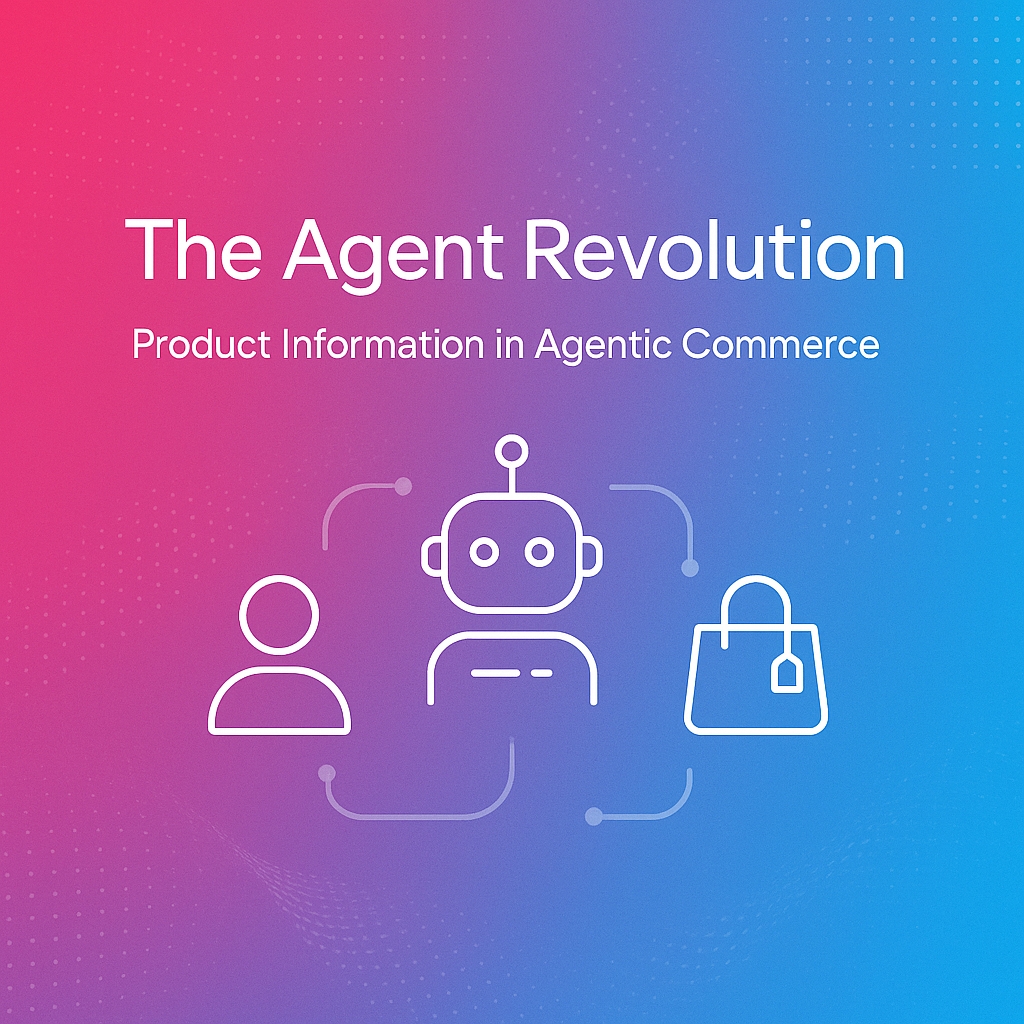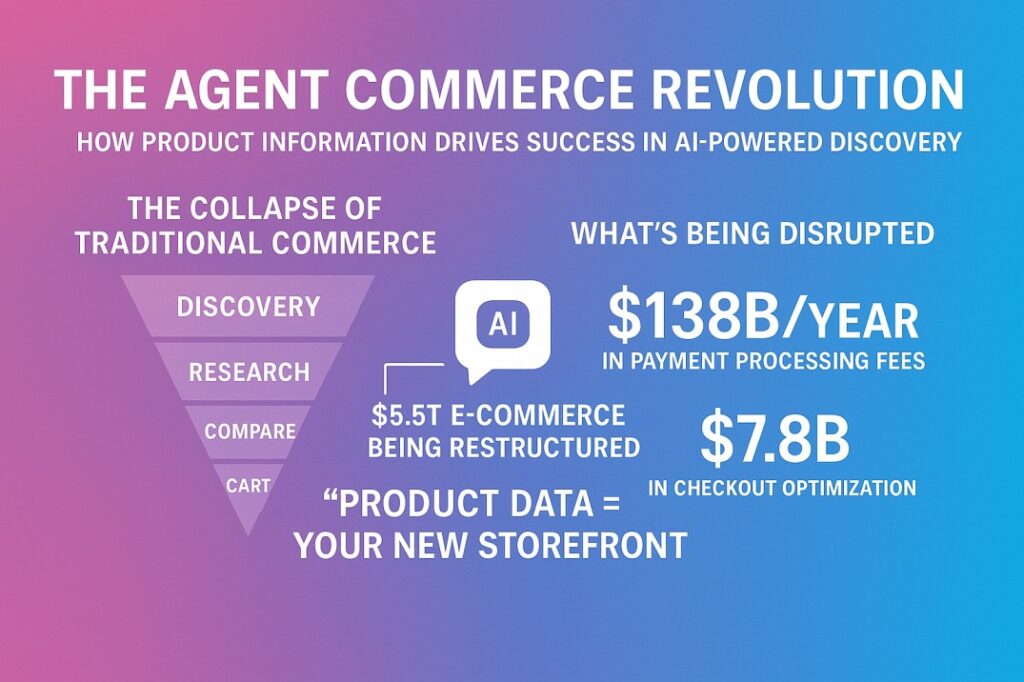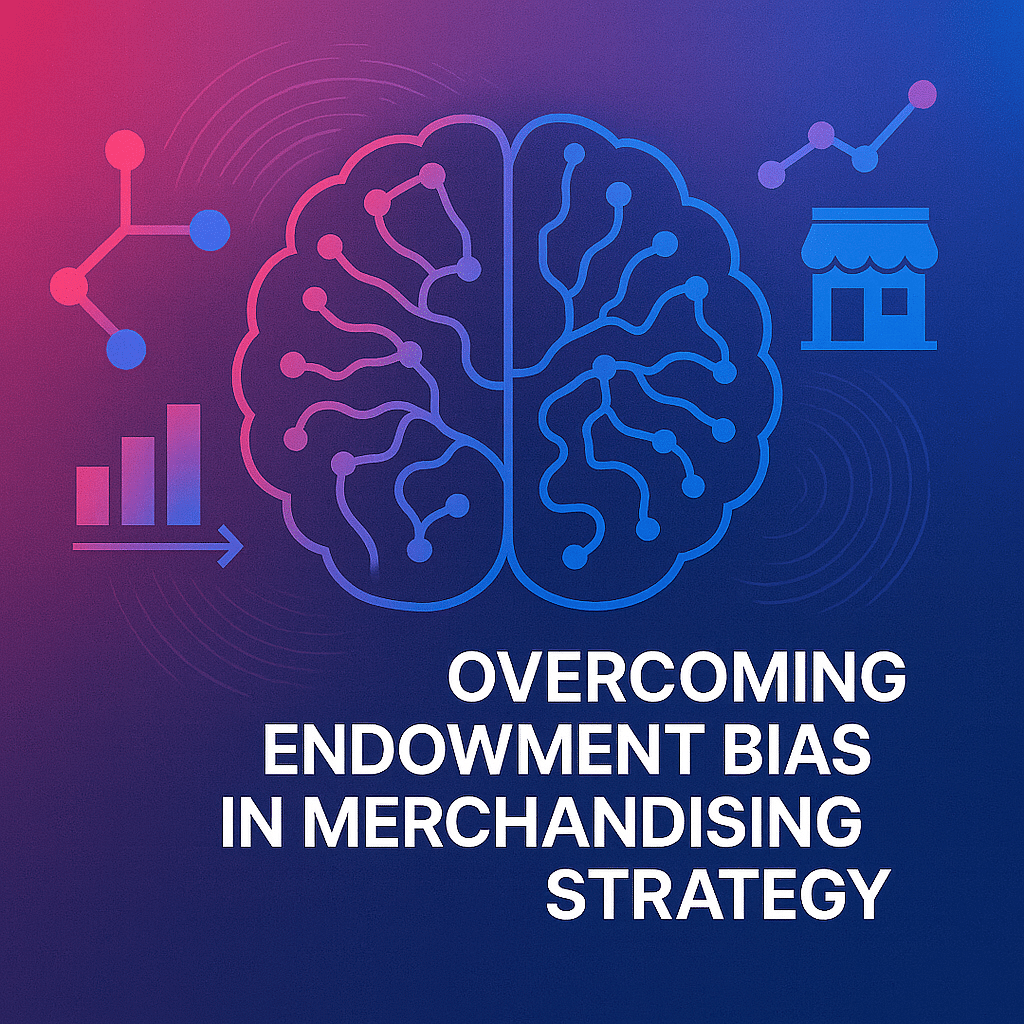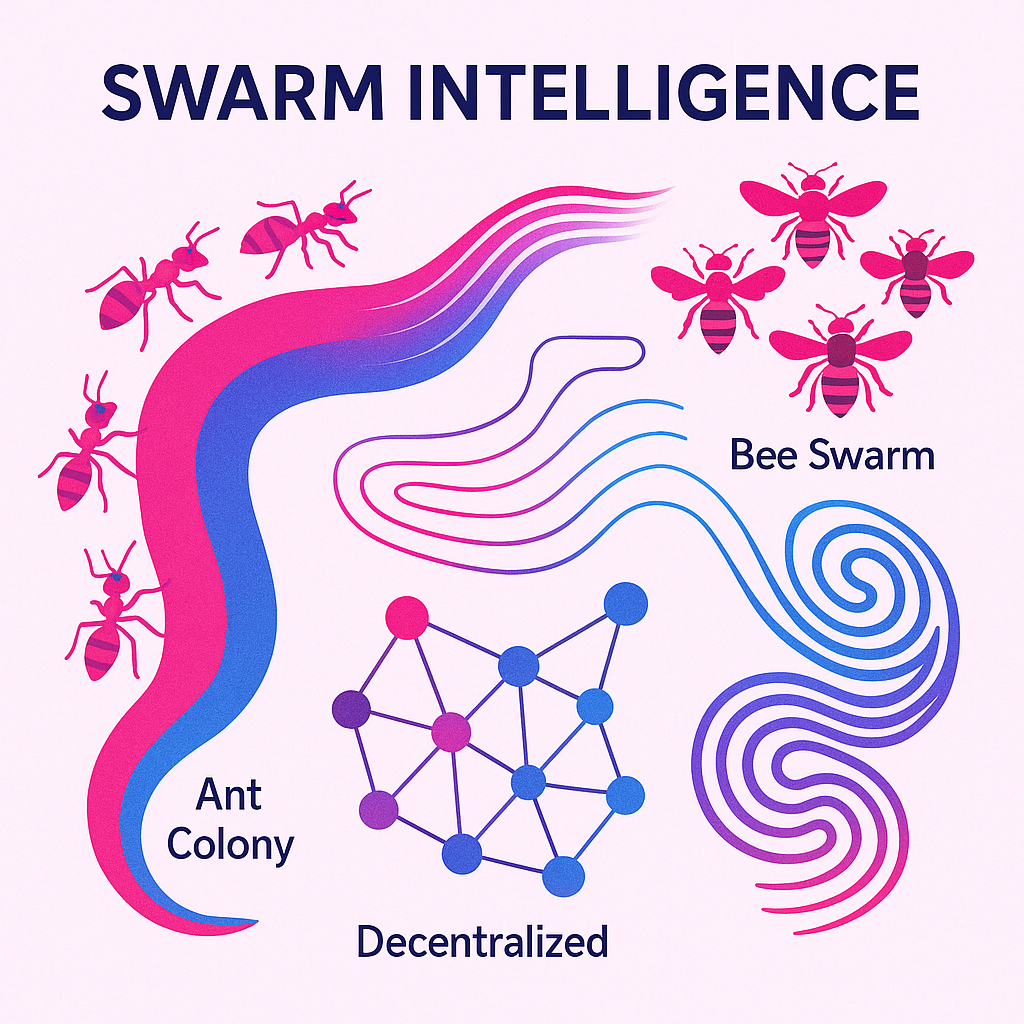The Agent Revolution: Why Product Information is the New Commerce Battleground in Agentic Commerce

What is Agentic Commerce?
Agentic commerce represents a fundamental shift in how consumers discover and purchase products. It refers to AI-powered shopping experiences where intelligent agents mediate the entire customer journey – from initial product discovery to final purchase – often bypassing traditional e-commerce websites and checkout flows entirely. Google’s recent introduction of “Shop with AI Mode” with Gemini 2.5 exemplifies this revolution, allowing consumers to complete purchases directly through AI interfaces without ever visiting a retailer’s website.
How is Agentic Commerce Different from Traditional E-commerce?
Traditional e-commerce follows a linear funnel: consumers discover products, research options, compare alternatives, add items to cart, and complete checkout across multiple pages and often multiple sessions. Agentic commerce collapses this entire journey into a single, fluid conversation with an AI agent that can simultaneously research, recommend, and execute purchases based on natural language requests. The fundamental difference is that in agentic commerce, the transaction happens at the moment of discovery, removing the traditional boundaries between browsing and buying.
The Strategic Construct: The Agent-Centric Commerce Model
1. Executive Summary
The retail landscape is experiencing a seismic shift with Google’s introduction of “Shop with AI Mode” and agentic checkout capabilities through Gemini 2.5. This isn’t merely an enhanced shopping experience—it’s a complete rewiring of the $5.5 trillion e-commerce stack where AI agents now mediate the relationship between consumers and products from discovery to purchase, bypassing traditional product pages and checkout flows entirely.
For brands and retailers, this transformation creates an urgent imperative: evolve your product information strategy or risk digital invisibility. As Marc Philippe B noted in his viral LinkedIn post, “When the transaction happens at discovery, everything shifts…Product data = your new storefront.”
Why is Agentic Commerce Disrupting Traditional Retail Models?
Agentic commerce represents a fundamental power shift in retail. When AI agents control the discovery-to-purchase journey, several critical disruptions occur:

- Disintermediation of Traditional Infrastructure: The $138B/year payment processing industry, $7.8B checkout optimization sector, and $37B e-commerce fraud prevention market all face dramatic restructuring as these functions become invisible infrastructure managed by AI platforms.
- Collapse of the Traditional Funnel: As one industry analyst noted, “Browser tabs will become a source of e-commerce nostalgia.” The multi-step journey from discovery to purchase compresses into a single conversation with an AI agent.
- Shift in Customer Ownership: Retailers lose direct customer relationships as AI platforms become the primary interface between consumers and products. Google’s announcement caused Shopify’s stock to drop 5% within hours, demonstrating Wall Street’s recognition of this fundamental power shift.
- Intent Capture as Value Driver: As transactions happen at the point of discovery, the entity that understands and fulfills consumer intent captures the most value—increasingly, that’s the AI agent, not the brand.
What Makes Product Information Critical in Agentic Commerce?
In the agent-mediated shopping experience, product information becomes the primary determinant of visibility and sales. Here’s why:
AI Discovery Requires Intent-Matching Data
When a consumer asks an AI agent for “a waterproof travel bag suitable for rainy Portland in May with easy-access pockets,” the agent initiates what Google calls a “query fan-out”—running simultaneous searches to build a comprehensive recommendation.
Products with information that clearly addresses these specific attributes and use cases will be recommended. Those without this depth of information become invisible to the AI, regardless of their actual suitability.
How Does the Product Information Hierarchy Change in Agentic Commerce?
The traditional approach to product information focused primarily on basic attributes and SKU data. In agentic commerce, a three-dimensional hierarchy emerges:
- Attribute Depth: Comprehensive technical specifications that allow AI systems to filter and match products against specific criteria.
- Contextual Relevance: Information about when, where, how, and for whom a product is appropriate across various usage scenarios.
- Intent Alignment: Language and terminology that matches how consumers naturally express their needs to AI systems.
Brands must now think beyond basic product specifications to create information architectures that anticipate and address the full spectrum of consumer intents and queries.
What Role Does Demand Intelligence Play in Optimizing for Agentic Commerce?
The traditional approach to product information is fundamentally supply-side: brands describe what they want to say about their products. This approach fails in the agent-centric world, which requires a demand-side approach: understanding and addressing what consumers actually want to know.
This is where Stylumia’s demand intelligence offers a transformative advantage.
How Does Stylumia’s Demand Intelligence Help Brands Succeed in Agentic Commerce?
Stylumia’s Consumer Intelligence Tool employs a proprietary AI-powered Demand Sensing algorithm that analyzes millions of consumer interactions to understand what truly drives purchase decisions. This demand intelligence enables brands to:
- Map the Intent Landscape: Understand the specific language, terms, and attributes consumers use when expressing needs to AI agents.
- Identify Critical Decision Factors: Determine which product attributes most strongly influence purchase decisions across different categories and segments.
- Optimize Information Architecture: Structure product data to maximize discoverability and relevance in AI-mediated shopping experiences.
- Predict Emerging Needs: Anticipate changes in consumer priorities and preferences before they impact purchase patterns.
By deploying Stylumia’s demand intelligence, brands can create product catalogs that naturally align with how consumers express their needs to AI agents, dramatically increasing the likelihood of recommendation and purchase.
What Steps Should Brands Take to Create Agent-Ready Product Catalogs?
Transforming your product information for agentic commerce requires a systematic approach:
1. Intent Mapping
Use demand intelligence to map the specific language, questions, and decision factors consumers consider when evaluating products in your category.
2. Information Enrichment
Enhance product data with the attributes, usage scenarios, and contextual information that align with identified consumer intents.
3. Language Optimization
Refine product descriptions to incorporate the terminology and framing that match how consumers express their needs to AI agents.
4. Structured Data Implementation
Implement comprehensive structured data (schema markup) that makes product information easily accessible to AI systems.
5. Continuous Optimization
Use ongoing demand intelligence to refine product information based on evolving consumer preferences and language patterns.
How Can Brands Maintain Their Identity in an Agent-Mediated World?
A critical challenge in agentic commerce is maintaining brand identity when AI mediates the customer relationship. The solution lies in finding the intersection between consumer intent and brand voice—creating product information that’s simultaneously discoverable by AI systems and authentically on-brand.
Demand intelligence helps brands navigate this paradox by:
- Identifying the overlap between consumer language and brand positioning
- Highlighting opportunities to inject brand personality while maintaining discoverability
- Uncovering unique brand attributes that resonate with specific consumer segments
What Does the Future of Product Intelligence Look Like?
As agentic commerce evolves, product information must transition from static catalogs to dynamic intelligence assets that:
- Adapt to Context: Provide different information depending on the consumer’s situation, needs, and query context.
- Learn from Interactions: Incorporate insights from how consumers engage with products to optimize future information presentation.
- Anticipate Needs: Proactively address potential questions and concerns before they’re explicitly asked.
- Connect Across the Ecosystem: Link to complementary products, services, and information that enhance the overall solution.
Conclusion: The Imperative for Action
Google’s introduction of agentic checkout through Shop with AI Mode represents the most significant restructuring of e-commerce since the advent of online shopping. In this new paradigm, the battle for consumer attention and loyalty will be won or lost based on the quality, depth, and intelligence of your product information.
Brands that leverage demand intelligence platforms like Stylumia to align their product catalogs with consumer intent will thrive in the agentic commerce economy. Those that continue to treat product information as a back-office function will find themselves increasingly invisible to consumers, regardless of the quality of their actual products.
What Benefits Do Brands Gain By Adopting an Agent-Ready Product Strategy?
Brands that successfully adapt to agentic commerce can expect several competitive advantages:
- Increased Discovery: Products optimized for AI agents will appear more frequently in recommendations, expanding reach without additional ad spend.
- Higher Conversion: When product information precisely matches consumer intent, conversion rates improve dramatically.
- Reduced Returns: Better pre-purchase information leads to more accurate consumer expectations and fewer returns.
- Market Intelligence: Structured analysis of agent-based discovery patterns provides unprecedented insight into consumer needs and preferences.
- Competitive Differentiation: As competitors struggle to adapt to agentic commerce, early adopters can establish dominant positions in AI-mediated discovery.
Ready to transform your product catalogue for agentic commerce, get in touch here for a free consultation…



